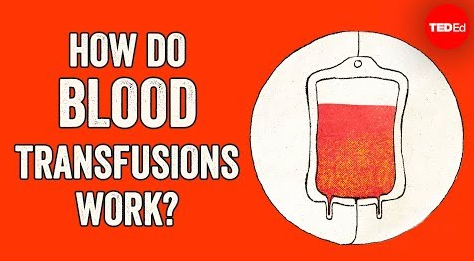In 1881, doctor William Halsted rushed to help his sister Minnie, who was hemorrhaging after childbirth.
在1881年,威廉·哈尔斯特医生匆匆忙忙赶去抢救他产后大出血的妹妹敏妮。
He quickly inserted a needle into his arm, withdrew his own blood, and transferred it to her.
他很快地将一根针头插进自己的胳膊,从中抽取出他自己的血,并将其输送给他妹妹。
After a few uncertain minutes, she began to recover. Halsted didn't know how lucky they'd gotten.
不安的几分钟过去后,她的身体开始恢复了。哈尔斯特并不知道他们当时其实很幸运。
His transfusion only worked because he and his sister happened to have the same blood type -- something that isn't guaranteed, even among close relatives.
他的输血过程之所以成功,是因为他和他妹妹恰好是同一种血型--而实际上,即使是至亲,都不一定能保证血型一致。
Blood types hadn't been discovered by Halsted's time, though people had been experimenting with transfusions for centuries -- mostly unsuccessfully.
在哈尔斯特所处的时代,血型还没有被人类发现,尽管到那时为止,人类已经试验过几千年的输血过程了--当然大部分情况下都失败了。
In 1667, a French physician named Jean-Baptiste Denis became the first to try the technique on a human.
在1667年,法国物理学家约翰-巴布缇斯·丹尼斯是第一位尝试在人身上进行输血的。
Denis transfused sheep's blood into Antoine Mauroy, a man likely suffering from psychosis, in the hopes that it would reduce his symptoms.
丹尼斯将羊的血转移到了安东尼·玛瓦的身体中,一位精神病患者,希望输血能改善他的症状。
Afterward, Mauroy was in good spirits.
第一次输血之后,玛瓦变得精神抖擞。
But after a second transfusion, he developed a fever, severe pain in his lower back, intense burning in his arm, and he urinated a thick, black liquid.
但在第二次输血后,他的症状转为了发烧,腰部感到剧痛,胳膊有强烈的灼烧感,并且他在小便的时候排出了一种浓黑的液体。
Though nobody knew it at the time, these were the signs of a dangerous immune response unfolding inside his body.
尽管在当时还没人了解那些症状,但那些症状其实标志着严重的免疫反应在他的体内进行着。
This immune response starts with the production of proteins called antibodies, which distinguish the body's own cells from intruders.
这种免疫反应从产生一种叫作“抗体”的蛋白质开始,它能将身体内部的细胞与入侵细胞区分开。
They do so by recognizing the foreign proteins, or antigens, embedded in an intruder's cell membrane.
这是通过识别嵌于入侵细胞膜中的蛋白质和抗原实现的。
Antibodies latch onto the antigens, signaling other immune cells to attack and destroy the foreign cells.
抗体附着于抗原上,标志着其他的免疫细胞开始攻击并摧毁外来细胞。
The destroyed cells are flushed from the body in urine.
被摧毁的细胞通过尿液从体内被排出。
In extreme cases, the massive break down of cells causes clots in the bloodstream
在极端情况下,这种大规模的细胞分解会堵住血管,
that disrupt the flow of blood to vital organs, overload the kidneys, and cause organ failure.
影响流到重要器官的血流,造成肾脏过载,并最终导致器官衰竭。
Fortunately, Denis's patient survived the transfusion.
幸运地是,丹尼斯的病人在那次输血后活了下来。

But, after other cross-species transfusions proved fatal, the procedure was outlawed across Europe, falling out of favor for several centuries.
但后来,跨物种输血被发现是致命的,这种手术后来在欧洲被法律禁止了,之后的几个世纪,这种手术渐渐被大家所遗忘了。
It wasn't until 1901 that Austrian physician Karl Landsteiner discovered blood types, the crucial step in the success of human to human blood transfusions.
直到1901年,奥地利物理学家卡尔·兰德施泰纳发现了血型,人与人之间血液传输的关键步骤。
He noticed that when different types were mixed together, they formed clots.
他发现当不同血型的血混在一起时,会形成血块。
This happens when antibodies latch on to cells with foreign antigens, causing blood cells to clump together.
当抗体依附于带有外来抗原的细胞上时,就会导致血细胞聚集在一起。
But if the donor cells are the same blood type as the recipient's cells, the donor cells won't be flagged for destruction, and won't form clumps.
但是当献血者的血型与受血者的血型相同时,献血者的血细胞就不会被标记为待摧毁,也不会形成血块。
By 1907, doctors were mixing together small amounts of blood before transfusing it.
到了1907年,医生们会在输血前先把少量的血混合在一起。
If there were no clumps, the types were a match. This enabled them to save thousands of lives, laying the foundation for modern transfusions.
如果不会形成血块,就说明血型相符。这使得他们拯救了成百上千的生命,为现代的输血手术奠定了基础。
Up to this point, all transfusions had occurred in real time, directly between two individuals.
到了现在,输血过程已经可以直接在两个个体之间实时传输了。
That's because blood begins to clot almost immediately after coming into contact with air -- a defense mechanism to prevent excessive blood loss after injury.
因为当血接触了空气之后,就会马上开始结块--一种用于避免受伤后大量失血的防御机制。
In 1914, researchers discovered that the chemical sodium citrate stopped blood coagulating by removing the calcium necessary for clot formation.
在1914年,研究者们发现柠檬酸钠这种化学物质,可以通过去除血液凝结所必须的钙物质来防止血液结块。
Citrated blood could be stored for later use -- the first step in making large scale blood transfusions possible.
柠檬酸钠血可被储存下来供之后使用--这使得大规模的血液传输变得有希望了。
In 1916, a pair of American scientists found an even more effective anticoagulant called heparin,
在1916年,两位美国科学家发现了一种更有效的抗凝剂:肝素,
which works by deactivating enzymes that enable clotting. We still use heparin today.
它可以灭活会造成血凝结成块的酶。直到现在我们都在使用着肝素。
At the same time, American and British researchers developed portable machines that could transport donor blood onto the battlefields of World War I.
与此同时,美国与英国的研究人员发明了便携式的机器,用它甚至能将献血者的血运往第一次世界大战的战场。
Combined with the newly-discovered heparin, medics safely stored and preserved liters of blood, wheeling it directly onto the battlefield to transfuse wounded soldiers.
再加上新发现的肝素,救护人员能安全地存储好几升的血,将它推到前线战场为受伤的士兵输血。
After the war, this crude portable box would become the inspiration for the modern-day blood bank, a fixture of hospitals around the world.
在战争结束后,这种简略的便携式运血盒为现代血库提供了灵感,现在血库已成为世界各地医院的固定设施了。












